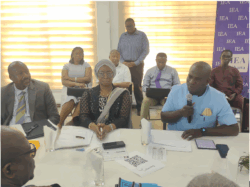Brutally murdered corpses lying in the backdrop of lush-green fertile farms, with legs and hands thrown akimbo – this is the horrendous imagery that has characterised the bloody relationship between local farmers and Fulani herdsmen in recent years.
As it has been in recent years, the wanton destruction of life arising from the fallout of these strategic agric stakeholders has once again managed to hug the news headlines in an otherwise positive year for the agric sector.
The recurring clashes between farmers and Fulani herdsmen are not only worrying -the situation is one that if not exhaustively dealt with could adversely affect the fortunes of our dear country’s agriculture sector. These skirmishes, though often easily diffused by the detachment of security operatives and occasional community dialogues, remain an abiding threat as they keep coming back in the form of reprisal attacks.
The farmers and herdsmen are both fundamental stakeholders in the agriculture sector, and it is regrettable that they have to go head-to-head in clashes that often leave death and destruction of valuable crops in its wake.
To fully appreciate the magnitude of the chaos that could result if we allow this to continue, one only needs to look in the direction of our West African neighbour, Nigeria. Nigeria’s inability to comprehensively deal with Fulani-farmer clashes has cost the country thousands of precious human lives, and has hampered growth of its otherwise vast agriculture sector. A report published in 2015 by aid agency Mercy Corps said the country could save as much as US$13.7billion annually if clashes between farmers and herdsmen stopped in several states.
Similarly, in 2016 violent clashes between Fulani herdsmen and local farmers in north-east Ivory Coast left 17 persons dead and a further 39 seriously injured. This bloody scenario has also been reported in Cameroon, Central African Republic and Burkina Faso.
Who are the Fulani’s?
The Fulani herdsmen are nomadic or semi-nomadic pastoralist whose major preoccupation is raising livestock. While the pure Fulani pastoralist engages in random movement of cattle, the semi-nomadic are more accustomed to moving their cattle around to graze and returning back to their settlements afterward.
They are thought to be the largest semi-nomadic group in the world, and are found across West and Central Africa from Senegal to the Central African Republic. The group is currently strewn across the sub-region due to effects of climate change, which continue to have adversely affect their most cherished possession – the cattle.
With continued interaction with other cultures, some Fulani’s have integrated into metropolitan life across some African cities – but unlike the more integrated city-dwellers, the nomadic groups spend most of their lives in the bush and are the ones largely involved in these skirmishes because they mainly herd their cattle across vast areas. They often clash with farmers whose farms are often inadvertently destroyed by Fulani cattle.
These herders are known to travel hundreds of miles in large numbers with their animals in tow to find grazing pasture. Because of the fear of robbers and wild animals that may attack their flock, it is not uncommon to find them armed with swords, bows and arrows, and sometimes locally-made guns.
Some of these herders are however notoriously irresponsible, and deliberately lead their herd to cultivated farmlands full of economic crops for their animals to feed; thereby destroying the livelihood of farming communities.
Even worse is the fact that ongoing arms conflict in Nigeria, Mali and Libya have made access to sophisticated assault rifles like AK 47 easy for some Fulani herdsmen to acquire; armed to the teeth with these, they allegedly rape female community members who encounter them in the bush, and kill as many that dare to confront them.
Timeline of Recent Fulani- Farmer Clashes
- In February 2016, Graphic Online reported the gruesome murder of two (2) Sissala resident farmers at Abrewanko by suspected Fulani herdsmen, who had attacked the duo on their farms.
- In March 2017, Fulani-farmer clashes led to the closure of six (6) schools serving fifteen (15) communities in the Kwawu East district of the Eastern Region.
- In September 2017, the Ghanaian Times reported the death of thirteen (13) people in clashes between Fulani herdsmen and Kokomba settler-farmers in the Kintampo North Municipality of the Brong Ahafo Region.
- In October 2017, Ghanaweb reported the killing of nine (9) Kwahu farmers at Dwerebeafe, Aboyan and Mpeamu communities.
- In November 2017, Citi FM reported the death of eight (8) people after clashes between Fulani herdsmen and local farmers at Dwibease and Wheewee communities in the Eastern Region.
While these numbers are terrifying, thankfully, the socio-cultural conditions that have fuelled the menace in Nigeria are not identical to what we have here in Ghana. But should we sit still and turn a blind eye? Successive governments have been quick to address these clashes, but efforts to permanently root-out the canker can only be best described as flaccid!
Ranching to the Rescue
Life must go on nonetheless, but if our agric sector is to live up to the high hopes elicited by government’s ‘Planting for Food and Jobs’, the focus on conflict resolution must also simultaneously explore a potential like ranching as a more permanent solution to the volatile situation.
Ranching is the practice of raising cattle and livestock for the purpose of milk, meat and other products like wool. The practice is usually done in open areas, with requisite structures and equipment needed to raise cattle and livestock animals. It is practiced mostly in the North American continent.
While the practice is not new to Ghana, the examples of ranching in Mexico, United States and Canada could be explored to bring lasting peace and further accelerate growth of the agric sector. The nomadic way of rearing cattle must give way to a more modern ranching system, which comes with numerous benefits that the nomadic system cannot match.
This view is corroborated by the Ghana Ranching Project Committee chairman, Dr. Oppong Anane who recently said: “Cattle must be confined, and this is what is done in so many countries. They confine the cattle, give them food and water, and they perform very, very well. It is high time that we go the same way”.
Similar sentiments have been expressed by the Eastern Regional Minister, Eric Kwakye Darfour who said: “I as a person, until about 1970 hadn’t even seen cattle before. But now cattle are everywhere…so the method we are using to breed and rear cattle in this country is primitive and we need to change, otherwise we will continue to have these altercations”.
The committee under the auspices of the National Security Ministry is tasked by government to develop effective strategies to bring a long-lasting solution to farmer-herdsmen clashes, and also improve the fortunes of cattle-rearing in Ghana. Suggested strategies are expected to become the basis for passage of a national ranching law.
A ranching law will define fenced territories to be used for breeding cattle and other livestock. Ranch owners will have to obtain a licence from district assemblies to commence operation. The Ghana ranching law was first mooted in 2012 as a solution to continued fatal clashes between indigenous farmers and the Fulani herdsmen.
Conclusion
It is fair to say Fulani herdsmen and farmers are key stakeholders on whose shoulders the fortunes of Ghana’s agriculture sector rest. Do you recollect the many times you pointed at the tasty-looking beef in the local chop-bar as your choice of meat to accompany your ‘fufuo’ and ‘nkatenkwan’?
While a fruitful relationship between these two transcends a combination of products from their stables in the preparation of meals, the above analogy is a manifestation of how a complimentary relationship between the two not only benefits each of them but also goes a long way to affect the entire country in a positive way.
There is absolutely no reason why precious human life should be lost because of animal grazing. Ghana needs both the herdsmen and farmers to stay alive and prosper, so that the agric sector will thrive in leaps and bounds. If we are to benefit optimally from the two stakeholders, we must learn from other countries who have managed the two effectively.
This is absolutely possible. If a vast country like India, which has animal husbandry as the mainstay of its rural economy, is able to manage farmer-herder relationships amicably, we cannot be absolved of blame for the violence that has claimed scores of farmers and herdsmen alike.
Similarly, South and North American giants Brazil and the United States produce 15% and 19% of the global beef stock respectively. However, because of proper legislation, the kind of clashes happening in Ghana is seldom heard of in those countries.
As we head into the future, we must accelerate the process of enacting ranching legislation so that we end the needless bloodletting. Ghana is acclaimed for its peaceful socio-political climate; we must therefore work hard to ensure that news headlines heralding stories of death arising from such clashes become a thing of the past in our motherland, Ghana.
About the Writer
Alberta Nana Akyaa Akosa is the Lead Consultant at Agrihouse Communications, the premier data-driven agro Public Relations, Media Relations and Events Management firm. She is also the Founder of Agrihouse Foundation, a non-governmental capacity building organisation, with a special focus on agro-based youth mentorship and leadership grooming, agribusiness development through the organisation of exhibitions, training programmes, research, agri-trade relations and promotions.
Her organisation manages the biggest annual USAID/ ACDI ADVANCE’s Agricultural exhibitions in the Northern Region – ‘The Pre-harvest Agribusiness Exhibitions and conference’, as well as the Poultry Value Added value chain fair (POVAC) and the Pre-season event.
Alberta is the project and communications consultant for the National farmers’ and fishermen award winners association (NFFAWAG), and the local organising partner for Reeds Exhibitions – a renowned global exhibition organiser behind the ‘Value Added Agriculture Fair’ in Ghana. She has successfully led her team to manage projects for marquee agric industry firms.
For general enquiries, please E-mail: [email protected]
The writer is the Lead Consultant and Founder – Agrihouse Communications and Agrihouse Foundation










